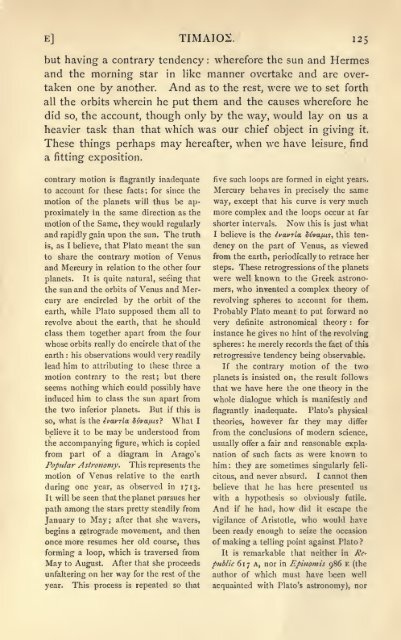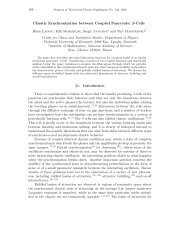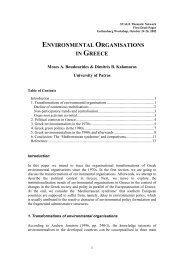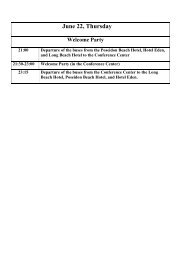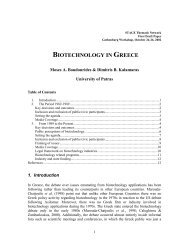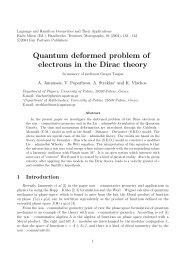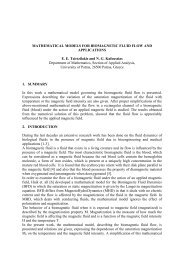You also want an ePaper? Increase the reach of your titles
YUMPU automatically turns print PDFs into web optimized ePapers that Google loves.
TIMAI02. 12$<br />
but having a contrary tendency wherefore the sun and Hermes<br />
:<br />
and the morning star in like manner overtake and are overtaken<br />
one by another.<br />
And as to the rest, were we to set forth<br />
all the orbits wherein he put them and the causes wherefore he<br />
did so, the account, though only by the way, would lay<br />
on us a<br />
heavier task than that which was our chief object in giving it.<br />
<strong>The</strong>se things perhaps may hereafter, when we have leisure, find<br />
a fitting exposition.<br />
five such loops are formed in eight years.<br />
contrary motion is flagrantly inadequate<br />
year. This process is repeated so that acquainted with <strong>Plato</strong>'s astronomy), nor<br />
to account for these facts; for since the Mercury behaves in precisely the same<br />
motion <strong>of</strong> the planets will thus be approximately<br />
way, except that his curve is very much<br />
in the same direction as the more complex and the loops occur at far<br />
motion <strong>of</strong> the Same, they would regularly shorter intervals. Now this is just what<br />
and rapidly gain upon the sun. <strong>The</strong> truth I believe is the ivavria. dfoa.fj.is, this tendency<br />
is, as I believe, that <strong>Plato</strong> meant the sun<br />
on the part <strong>of</strong> Venus, as viewed<br />
to share the contrary motion <strong>of</strong> Venus from the earth, periodically to retrace her<br />
and Mercury in relation to the other four steps. <strong>The</strong>se retrogressions <strong>of</strong> the planets<br />
planets.<br />
It is quite natural, seeing that were well known to the Greek astronomers,<br />
the sun and the orbits <strong>of</strong> Venus and Mercury<br />
who invented a complex theory <strong>of</strong><br />
are encircled by the orbit <strong>of</strong> the revolving spheres to account for them.<br />
earth, while <strong>Plato</strong> supposed them all to Probably <strong>Plato</strong> meant to put forward no<br />
revolve about the earth, that he should very definite astronomical theory : for<br />
class them together apart from the four<br />
whose orbits really do encircle that <strong>of</strong> the<br />
earth : his observations would very readily<br />
instance he gives no hint <strong>of</strong> the revolving<br />
spheres he merely records the fact <strong>of</strong> this<br />
:<br />
retrogressive tendency being observable.<br />
lead him to attributing to these three a If the contrary motion <strong>of</strong> the two<br />
motion contrary to the rest; but there planets is insisted on, the result follows<br />
seems nothing which could possibly have<br />
induced him to class the sun apart from<br />
that we have here the one theory in the<br />
whole dialogue which is manifestly and<br />
the two inferior planets. But if this is<br />
flagrantly inadequate. <strong>Plato</strong>'s physical<br />
so, what is the tvavria. 8'jva.fus? What I theories, however far they may differ<br />
believe it to be may be understood from<br />
accompanying figure, which is copied<br />
from the conclusions <strong>of</strong> modern science,<br />
usually <strong>of</strong>fer a fair and reasonable explanation<br />
from part <strong>of</strong> a diagram in Arago's<br />
<strong>of</strong> such facts as were known to<br />
Popular Astronomy. This represents the him: they are sometimes singularly felicitous,<br />
motion <strong>of</strong> Venus relative to the earth<br />
and never absurd. I cannot then<br />
during one year, as observed in 1713. believe that he has here presented us<br />
It will be seen that the planet pursues her with a hypothesis so obviously futile.<br />
path among the stars pretty steadily from And if he had, how did it<br />
escape the<br />
January to May; after that she wavers, vigilance <strong>of</strong> Aristotle, who would have<br />
begins a retrograde movement, and then been ready enough to seize the occasion<br />
once more resumes her old course, thus <strong>of</strong> making a telling point against <strong>Plato</strong> ?<br />
forming a loop, which is traversed from It is remarkable that neither in Republic<br />
May to August. After that she proceeds<br />
617 A, nor in Epinomis 986 E (the<br />
unfaltering on her way for the rest <strong>of</strong> the author <strong>of</strong> which must have been well


